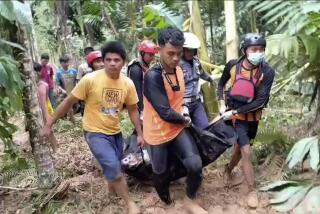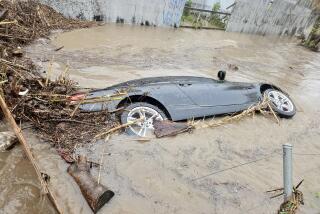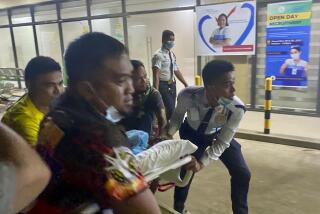Typhoon in Philippines leaves nearly 300 dead, hundreds missing
As Typhoon Bopha veered west from the Philippines on Wednesday, disaster officials continued their grim tally in its wake, counting nearly 300 deaths from the overpowering storm.
The storm knocked over trees, destroyed homes and triggered devastating floods, including an unexpected burst of water in Compostela Valley province that swept away soldiers and swamped emergency shelters that had been believed to be safe. Nearly half of the storm deaths occurred in that province, according to government counts released Wednesday.
As of Wednesday evening in the Philippines, disaster relief officials had only identified 26 of the 274 people who were known to be killed.
The death toll is feared to grow still higher as rescuers search battered areas caked with mud and strewn with the wreckage of collapsed homes. Downed electrical wires and damaged bridges have hindered crews from reaching some villages. Hundreds more people remain missing.
Dead bodies lay side by side in the village of New Bataan after the typhoon barreled on, leaving distraught villagers to search the corpses for friends and family. As he studied the dead, Juniper Serato told the Philippine Daily Inquirer that he was looking for six missing family members, including his parents.
He stopped after spotting a friend. “I know him,” he told the paper.
Others tried to find their loved ones online, using a Google website to submit information about people and search reports for names of friends and family. Twitter hash tags #rescuePH and #reliefPH helped connect Filipinos seeking help.
More than 217,000 people were affected by the deadly storm, known in the Philippines as Pablo, including more than 167,000 people seeking help at government evacuation centers, according to disaster officials. The typhoon stranded nearly 4,400 passengers in ports across the Philippine archipelago, scuttled scores of flights and cut off power and clean water to some parts of the islands.
Though heavy storms hit the Philippines every year, they usually batter the northern and central stretches of the country, not the southern islands where Bopha struck. The powerful storm came less than a year after Typhoon Washi slammed the south, claiming more than 1,200 lives.
Aid agencies and government officials said the memory of Washi had spurred families to leave their homes hours before the latest storm struck. Paul del Rosario, humanitarian coordinator for Oxfam in the Philippines, praised government efforts.
Those preparations, “plus the cooperation of affected residents, indeed saved lives,” Del Rosario said in a statement issued Wednesday by the nonprofit.
But the United Nations humanitarian office said food, water and shelter were badly needed as the storm cleared. Many displaced families are camping out in the open in areas sullied with mud. The typhoon also stripped some mountainsides of vegetation, raising fears that farms could be crippled in the aftermath of the typhoon.
ALSO:
Police actions questioned after Mexican inauguration protests
Israel moves forward with controversial West Bank development
Indian Olympic officials defy IOC, pick corruption suspect as leader
More to Read
Start your day right
Sign up for Essential California for news, features and recommendations from the L.A. Times and beyond in your inbox six days a week.
You may occasionally receive promotional content from the Los Angeles Times.






